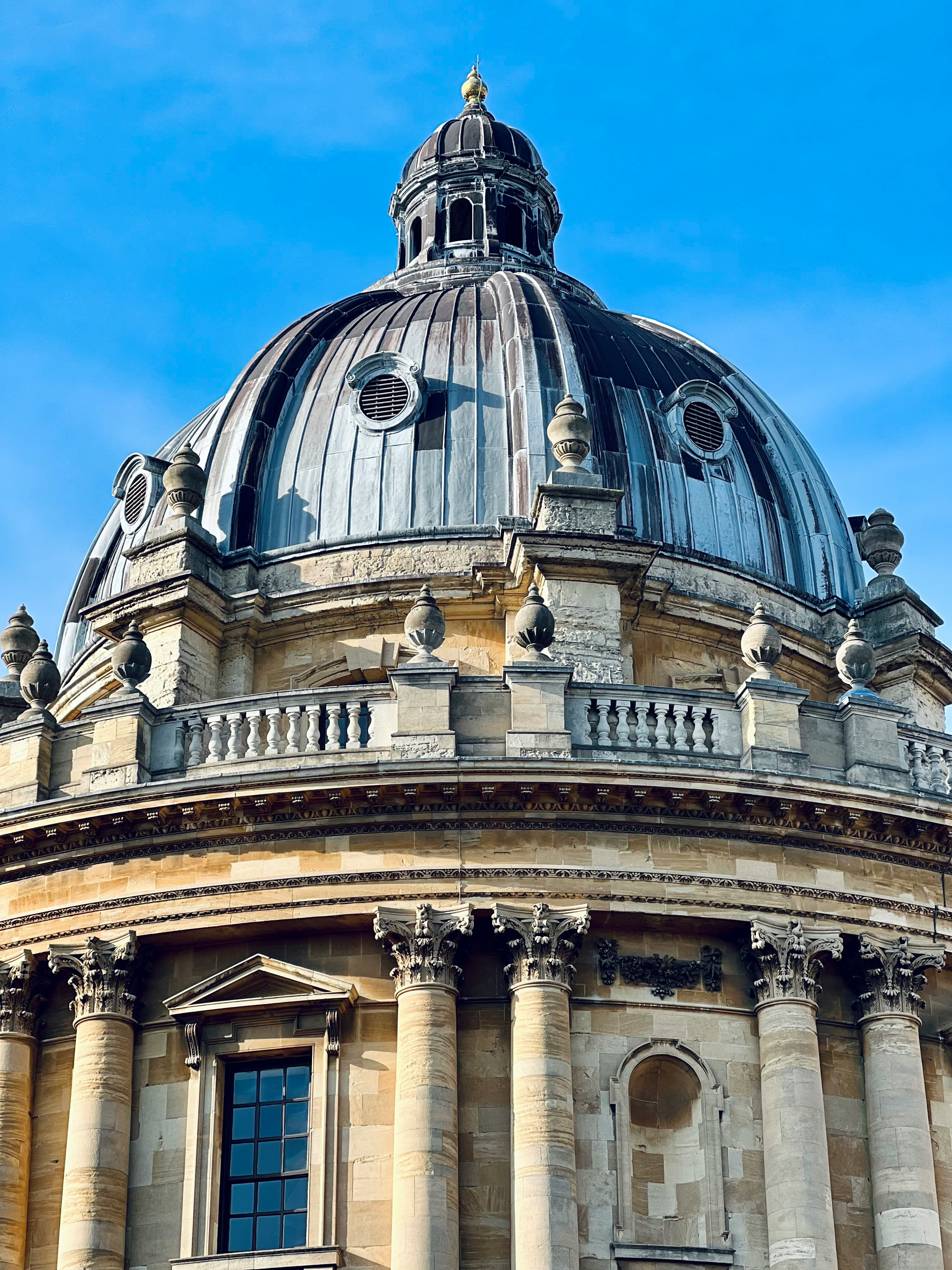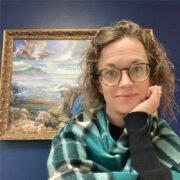Additional Thoughts on the School of Astronomy and Rhetoric

Much like Lindsey Rall, I also recently had the opportunity to take in the sights of Oxford. Once there, it didn’t take me long to walk into the courtyard of the Bodleian where the doors to the medieval lecture halls stand. Like Mrs. Rall, I paused in front of the door to the Schola Astronomiae et Rhetoricae. After a gasp of giddiness, I also had a wondering: why is astronomy listed first?
In modern classical education, schools can almost always speak to the Trivium, but rarely to the Quadrivium. There seem to be as many interpretations of the Trivium and its purpose as there are classical schools, but significantly fewer interpretations of the quadrivium, so it’s worth calling one to mind: Arithmetic is the art of number, geometry, the art of number in space, music, the art of number in time, and so astronomy is the art of number in space and time. The combination of space and time within the art of astronomy hints at an underlying combination of phenomena within the art of rhetoric.
The components which create the arts within the quadrivium are three in number: 1) number itself, 2) space, and 3) time. The existence of these components ought to cause us to wonder about the make-up of the Trivium. The first component is simple: language. The second and third components, however, become trickier. We must look to geometry and music to help us understand. In practical application, the art of geometry assumes that shape exists—shape being the boundary lines of an object, whether real or imagined. The whole art predicates itself on this idea that there is either a tangible or theoretical object that takes up space, and because it takes up space, there are true statements we can make about it. If we apply that way of thinking to the art of logic, then we must consider its practical application. If the art of geometry assumes that shape exists, then what does the art of logic assume? I would answer that it assumes that truth exists—truth about both observable and non-observable entities. The art of music asserts that time exists, and that there are moments in time that work in relation to other moments. In my view, logic is on an equal playing field with the arts of both geometry and music: what is this line’s relation to that line is the same kind of question as what is this statement’s relation to that statement—or this silence’s relationship to that silence? Those arts simply view number as being in relationship with other numbers. We need not question, then, whether rhetoric’s counterpart is music, for the counterpart of logic is both music and geometry.
This leaves us to consider what bearing astronomy has on rhetoric. If astronomy is the art of number considered in space and time, then rhetoric also would need two considerations affecting the use of language.
For Plato those two considerations are knowledge and belief. In the Gorgias, Gorgias and Socrates agree that the only kind of knowledge is true knowledge, but that there are two kinds of belief: true belief and false belief. Aristotle argues in his Rhetoric that the syllogism is the basis of the art of dialectic, a sub-art of logic. Rhetoric, he asserts, is dialectic’s counterpart, and as such must work with language through the medium of the enthymeme, a vehicle of true belief. However, he is very clear in his first chapter of the Rhetoric that the rhetor cannot ethically use false belief as a means to an end. If the rhetor is going to use belief (and he or she must) then it must be true belief. My students wonder with me: what is the difference between knowledge (which can only be true) and true belief?
We’ve not answered that question in class, but Mrs. Rall’s musings have caused me to consider: are time and space in the same relationship as true knowledge and true belief?
Just before I boarded the plane to Oxford, I accepted a request that is common in many classical schools—to teach something I’d never taught before. I’ve accepted a handful of teaching positions like this over the years. In this instance, I let my administrator know that I would take a position that had been difficult for her to fill: Logic School Astronomy. #planets, y’all.
I’m a rhetoric teacher, and I don’t mean I teach in my school’s Rhetoric school, although I do. I teach rhetoric, the art, to high school students. And now, apparently, I was teaching astronomy to middle school students. So, when I happened upon the door at the Bodleian, I was giddy in the nerdiest way possible.
Here’s the thing about belief: it’s a strictly human ability. Apart from humans and higher ordered beings, animals do not hold beliefs—they work from instincts. This is one of the reasons that logic doesn’t deal in belief, but only knowledge: logic is man’s highly structured search for what is true about the real world. A man can practice the art of logic on his own, but he is better off doing it with his friends so that in the end they all find truth together. Rhetoric, on the other hand, is man’s significantly less structured attempt to lead others to truth. Since the currency of rhetoric is belief, and only humans have beliefs, then the relational human element is the second consideration of the arts of language; the first is truth. Thus, in the quadrivium we have number, space, and time, while in the trivium we have language, truth, and humanity.
Just like the art of astronomy cannot be practiced without considering both time and space, the art of rhetoric cannot be practiced without consideration of truth and other humans. In The Trivium, Sister Miriam Joseph states that rhetoric is the adaptation of language to circumstance. Circumstance is one of the five common topics and to practice it, students answer questions related to time and place (place simply being a point in space). In Aristotle’s Topics, the topics related to circumstance have to do with past action, future action, possibilities, and impossibilities. Past and future take care of the time aspect while ‘The Possible’ takes care of space. If we allow ourselves some leeway with Sister Miriam Joseph’s definition, then rhetoric is the movement of language in relation to time and space. It’s like a solar system of words + ideas.
Did you know that in between Mars and Jupiter there lies an asteroid belt? Most of us learned this at one point or another in our education. But did you also know that mathematically speaking, the asteroid belt is the remains of a failed planet, one that because of its potential size, its relation to Jupiter, Mars, and the Sun, began to form and then failed because Jupiter is so large, the Sun is so far away, and well…there’s Mars too. As a first year Astronomy teacher that’s about the best I can do to converse with my students about the presence of the asteroid belt.
Much like planets interact with other planets, in the art of rhetoric, humans must interact with other humans, but they must also interact with knowledge and belief. Some of those beliefs will be true and some of those beliefs will be false. If the rhetor adapts his argument to suit those around him, then he may succeed in leading his audience to truth, but it will be very unlikely. It would be more likely that the rhetor would descend into a practice of sophistry. But if the rhetor orients himself to truth, and then adapts his argument to suit those around him, then not only can he lead them to truth, but he’s much more likely not to cause a cataclysmic event in another person’s soul. He still may not succeed with his audience, but at the very least, he will maintain his fixed orbit around truth, which as we know is only one of the many phenomena that Christ the Logos holds in Himself.

Mary Pat Rogers
Mary Pat Rogers lives with her husband, two children, and two dogs in the foothills of the Sangre de Cristo Mountains. She trains students in the art of rhetoric at Oak Grove Classical Academy.











1 thought on “Additional Thoughts on the School of Astronomy and Rhetoric”
Mary, I really enjoyed reading this! How incredible that we were both in the same spot and took away similar but also unique points. I hope your trip was wonderful.